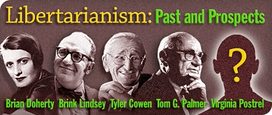Lead Essay
Beginning with a riff on Brink Lindsey’s appeal to the “liberaltarian” left, and David Boaz and David Kirby’s analysis of the libertarian vote, Brian Doherty, author of Radicals for Capitalism: A Freewheeling History of the Modern American Libertarian Movement, notes that “realistic talk of a “libertarian voting bloc” for major parties to fight over — the idea that a double-digit percentage of Americans can be assumed to be in line with libertarian ideas — is a major miracle in libertarian movement terms.” Back in the 1970s, Doherty reports, “the notion that an explicitly libertarian institution should even seriously think about effecting real-world political change was considered — well, it was not really considered at all…” What, then, does history tell us about the best strategy for creating a more libertarian future? “The very libertarian answer is: libertarian energies ought to go to wherever any given libertarian wants them to,” Doherty argues. “The division of labor, operating through free choice, is as valid here as in any other aspect of the economy.”
Response Essays
Things may look bleak for libertarians these days, but there are grounds for hope, says Cato’s vice president for research (and Cato Unbound editor) Brink Lindsey. Though few Americans self-identify as “libertarian,” there is nevertheless a deep libertarian streak in American culture and a large group of voters who say they are “fiscally conservative and socially liberal.” In the long term, Lindsey argues, the goal for libertarians is to multiply the number of libertarians, and he concurs with Doherty in saying “let a thousand flowers bloom.” However, Lindsey argues that in the short term “what needs to be developed is a set of ideas that can serve as the basis for a new political identity. Not a strictly libertarian identity — there simply aren’t enough strictly defined libertarians to base a mass political movement on. Rather, a genuinely liberal identity — one that brings together ‘fiscally conservative, socially liberal’ voters from across the current left-right spectrum.”
According to Marginal Revolution blogger and New York Times “Economic Scene” columnist Tyler Cowen, there have been a few truly great libertarian developments since the 1970s. However, he argues, they “also brought much bigger government. The more wealth we have, the more government we can afford. Furthermore, the better government operates, the more government people will demand. That is the fundamental paradox of libertarianism. Many initial victories bring later defeats.” Cowen argues libertarians accept this paradox, reconcile themselves to the welfare state, recognize positive liberty as more important than negative liberty, and restructure libertarianism around new threats to liberty such as global warming, pandemics, and nuclear proliferation. Such a libertarianism, Cowen admits, would “run the risk of losing its intellectual and moral center. … Many people fear such a development, and I can understand why.”
In his reply, Cato senior fellow Tom G. Palmer maintains that Brian Doherty is guilty of “a confusion of two related projects: the promotion of liberty and the promotion of libertarianism, i.e., the theory that liberty should be the primary (or overriding) goal of a political order.” It is possible to promote liberty without promoting libertarian philosophy. This distinction motivates Palmer to dissent from Doherty’s emphasis on education. No amount of libertarian education will make a difference, Palmer argues, unless someone acts to make change for liberty. “If I were to put it as a slogan, it might be: ‘Education doesn’t eliminate trade barriers, legislators do.’” Palmer also quibbles with Doherty’s focus in his book on zany libertarian characters and with his laissez faire approach to promoting liberty.
Atlantic columnist and former Reason editor-in-chief Virgina Postrel argues: “Rather than defining ‘libertarian’ by appealing to deductive logic and so-called first principles, we can better understand the American libertarian movement as a sometimes uneasy amalgam of four distinctive yet complementary traditions, two cultural and two intellectual.” Intellectually, she points to “two seemingly incompatible intellectual traditions”: the modernist Rand-Rothbard quest for certainty “as rational and precise as a skyscraper, as ahistorical as Le Corbusier’s plans to remake Paris” and the empiricist Hayek-Friedman/Hume-Smith tradition, which “looks for understanding, for facts, and for solutions to specific problems.” Drawing on her book The Future and Its Enemies, Postrel warns against fighting the old fights between capitalism and socialism when the real battles is between “stasism” and “dynamism.” She plumps for the possibility of an alliance of libertarian and left dynamists against stasists of all stripes, but concludes with a challenge to the left: “We know we’re liberals. The question is, Are they?”
The Conversation
Related at Cato
» The Libertarian Vote by David Boaz and David Kirby
» Liberaltarians by Brink Lindsey
» Libertarianism: A Primer by David Boaz
» The Age of Abundance: How Prosperity Transformed America’s Politics and Culture by Brink Lindsey

